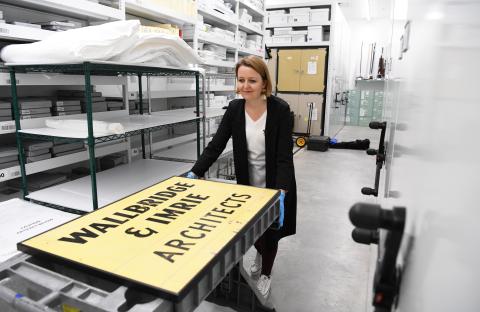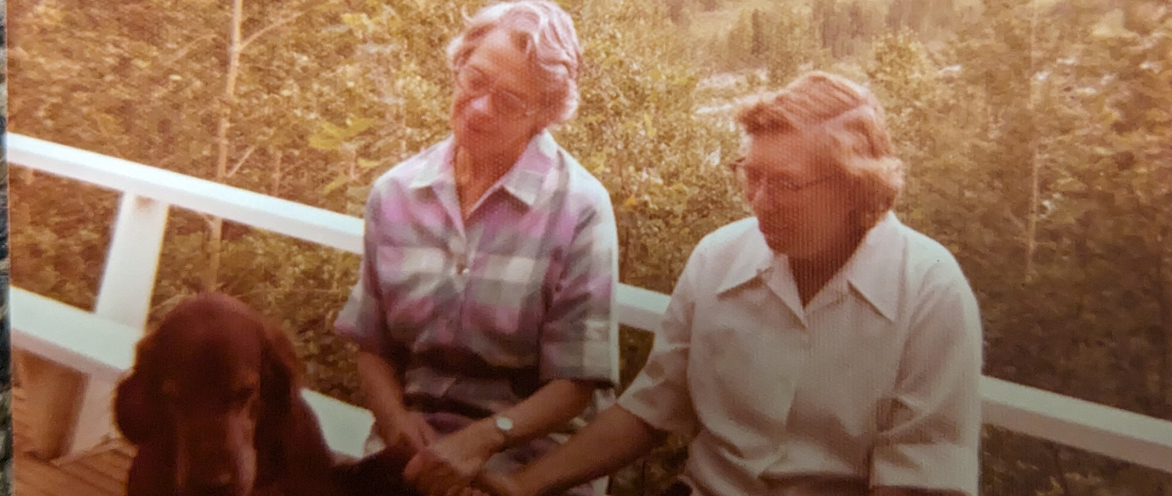On their own terms: the Legacy of Wallbridge and Imrie
By Jillian Richardson, Curator, Labour and Industry
October 3, 2024
Jean Wallbridge and Mary Louise Imrie are two incredible Alberta women who broke many barriers in their lifetime, both in their professional field and in their personal lives.
They were among the first women in Canada to register as architects in the early 1940s. Both women began studying architecture prior to the Second World War, at a time when only about 20% of the workforce was female. Both began their careers as city planners in Edmonton, fighting for respect and recognition in a male-dominated industry. Later, they formed “Wallbridge and Imrie Architects,” the first women-run architectural firm in Canada in 1950. Throughout their incredible partnership, they completed 224 architectural projects in 29 years.
Many historians think they were also a couple, as they lived together under one roof in a house they designed and built called Six Acres.
Their story weaves together many threads of history — of women’s emerging professional lives in the 1940s and 50s; of combatting gender stereotypes in the male-dominated industry of architecture; and of two women living together on their own terms.
How do we, as a museum, preserve and share these stories? And how do we know how women like Jean and Mary wanted their stories to be shared and preserved?
The RAM collection
Although I have worked in public history in Edmonton for more than a decade and spent several years developing history exhibits for the Royal Alberta Museum, I confess that I had not heard of Wallbridge and Imrie until February of last year. I was contacted by a researcher looking for information on Jean and Mary’s careers, and they wanted to view any artifacts that we might have in our collections.
After learning a little about these two women, it seemed obvious that we would have items from Jean and Mary in our collection: they were the first women’s architecture firm in Canada; were instrumental in Edmonton’s early planning history; were passionate about land conservation and had donated several properties to the province. The Provincial Archives held an extensive collection of Jean and Mary’s photos, negatives, glass slides, and cinefilms. They have been the subject of two master’s theses, numerous articles, and a forthcoming book based on their important contributions to architectural history and the history of the 2SLGBTQ+ community in Alberta.
And, indeed, here at the RAM we did have collections related to both Jean and Mary... However, these objects told us very little about Jean and Mary’s lives, their business, and their important contributions to Alberta history.
Instead, we found that when Jean was 20 years old, in 1932, she was presented as a debutante at Buckingham Palace in London, England. Jean’s court presentation gown, including veil, train, and ostrich-feather fan, is at our museum, along with the newspaper documentation and ceremonial ephemera related to the event.
We also have Mary’s hat from her Klondike Days costume, c. 1950, which was donated by her friend Eleanor after Mary passed away in 1988.
This is not to say that these aren’t important objects, but these items fail to capture the measure of Jean and Mary’s importance to Alberta history.
Rather, these objects really highlight how women’s domestic histories have overwritten their contributions to labour history, to STEM professions, and to the history of Alberta’s 2SLGBTQ+ community.
Is this the legacy that Jean and Mary wanted to leave behind, the stories that they wanted to tell?
Collecting more of Wallbridge and Imrie’s story
After learning about Wallbridge and Imrie, I immediately began seeking collections that would help us to tell the rest of their story.
I learned that although several boxes of material had been transferred to the Provincial Archives years ago, none of the house’s contents made their way into the museum collection, and some artifacts remained in the house that Wallbridge and Imrie designed, built, lived in and worked out of.
After several emails, visits to the site, investigations of government records, and research, we were ultimately able to secure the donation of those items in October of 2023.
Through these objects we are starting to piece together a more detailed picture of Jean and Mary’s personal lives from the 1950s to the 1980s. Domestic objects like clocks, family photos, travel souvenirs, and personal artworks tell us a lot about these two women. We learned, for example, that both were amateur plein-air painters. And they were avid travelers, visiting Europe, South America, Japan, and India.
We also have the objects that will allow us to tell the stories of their professional lives—their business cards, personalized architectural tools, business stamps, an office chair. And, the original “Wallbridge & Imrie Architects” sign, which hung outside their home and office known as Six Acres.

Collecting women’s stories
Acquiring these items, however, is somewhat bittersweet. Many other artifacts have disappeared over the years, having been thrown out as a result of damage, or simply because they were too “common” or too “modest” to be deemed important.
In many of the things I’ve read about Jean and Mary, they are both described as modest—in spite of having each come from privileged families, they were not extravagant, but focused on simplicity, the outdoors, and their community.
A fellow researcher once shared with me that when the University of Toronto wanted to include Mary in an exhibition about graduates from their program, she replied that she couldn’t understand why they would want to write about her, that she wasn’t very interesting.
In the past, women’s modesty—both the “modesty” of their professional accomplishments--because their gender limited them to certain kinds of projects—and their personal modesty about their own lives and achievements, kept them out of the historical record…including at our museum.
Collecting stories of 2SLGBTQ+ history
Another limitation is our ability to collect and share histories related to the 2SLGBTQ+ community.
At this point, very little of the museum’s historical collection acknowledges gender and sexuality—let alone in modern terms—we have rarely focused on those details as being central to an object’s history (except to, say, call a pair of trousers “ladies’ trousers” or “men’s trousers,” for instance.) Often we have limited ways of knowing that the objects in our collection speak to 2SLGBTQ+ history, and so it becomes hard to tell those stories at all.
When you pair that with the understanding that, for a long time, members of the 2SLGBTQ+ community were forced to live in secrecy, the ability to collect objects that share those stories are difficult to come by. Then, it becomes a fine balance between respecting the privacy of individuals who are not here to speak for themselves, and our social responsibility to acknowledge and share inclusive histories.
We are trying to fill this significant gap by bringing in new collections, but also by asking people to share how their objects should be interpreted—the stories they want them to tell. We’re not interested in collecting objects just because they are expensive, old, or beautiful. We are interested in objects because of the stories they can tell, by the individuals who donate them.
We are happy that we’ve been able to collect more objects and stories that better capture Jean and Mary’s lives and careers, outside of a debutante gown and a Klondike days hat. My hope is to continue to share their collection, and hopefully—eventually—create an exhibition on how women have shaped our built environment. But in the meantime, the collection has already been visited by multiple researchers interested in Jean and Mary’s work, and we’ve been able to use the collection in presentations celebrating Pride and 2SLGBTQ+ history in Alberta.
If there’s one point I hope people will take from this project, it’s that if you don’t see something on display in the museum, it might be because we don’t have it, or because someone in history didn’t know that it was important. But these stories – of women in STEM professions, the 2SLGBTQ+ community, of professional architecture – are important, and we do want to share them!
So, please collect your story, think about its meaning, and what you would like to see reflected in your museum. If you have objects that can help us to tell more diverse stories, we want to hear from you. Please get in touch!
Many thanks to Patricia Leake for introducing me to Jean and Mary’s history, and to Devon Moar and Cheryl Mahaffy for their help with researching this collection
